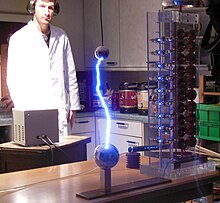
A Marx generator is an electrical circuit first described by Erwin Otto Marx in 1924.[1] Its purpose is to generate a high-voltage pulse from a low-voltage DC supply. Marx generators are used in high-energy physics experiments, as well as to simulate the effects of lightning on power-line gear and aviation equipment. A bank of 36 Marx generators is used by Sandia National Laboratories to generate X-rays in their Z Machine.
- ^ Marx, Erwin (1924). "Versuche über die Prüfung von Isolatoren mit Spanningsstößen" [Experiments on the Testing of Insulators using High Voltage Pulses]. Elektrotechnische Zeitschrift (in German). 25: 652–654. ISSN 0424-0200. OCLC 5797229.. This reference is suspect: the year 1924 and volume 25 do not match; the year 1924 corresponds to volume 45; volume 25 would be too early for Marx. Volker Weiss says 1925 and volume 45 which would also be wrong. Electrical World https://books.google.com/books?id=o3FEAQAAIAAJ&hl=en suggests Marx' Flashover testing article was June 11, 1925.